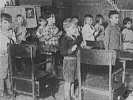I. Overall Compiler Organization
- what's in the front/back end
- what the job of each phase is
II. Lexical Analysis
Terminology
Regular expressions
- the notation
- *how you build them, concrete examples
- advantages
- limitations
- naming them
Scanners
- 4 steps: RE -> NFA -> DFA -> code/tables
- why use an NFA? a DFA?
- constructing an NFA
- constructing a DFA
III. Syntactic Analysis
Context-free grammar
- BNF: terminals, nonterminals, productions
- how you build them, concrete examples
- advantages
- limitations
Derivations
- abstract vs. concrete (parse) syntax trees
|
Parsing algorithms
- top-down vs. bottom-up
- predictive parsing
- table-driven & recursive descent implementations
LL(1) grammars
- ambiguity & fixes
- meta-rules (code/precedence tables)
- rewrite grammar
- change language
- common prefixes (left factoring)
- left recursion
Building a table-driven predictive parser
- *PREDICT(nonterminal, input symbol)
- *FIRST(RHS)
- *FOLLOW(nonterminal)
IV. Semantic Analysis
Type checking basics
- examples
- type checking algorithm: bottom up
Symbol table
- attributes for each type of symbol
- scopes:
when created,
how used,
why have them
- handling procedures
- handling records
Strong, weak, static, dynamic typing
Type equivalence
* = less important
|


 CSE Home
CSE Home About Us
About Us Search
Search Contact Info
Contact Info